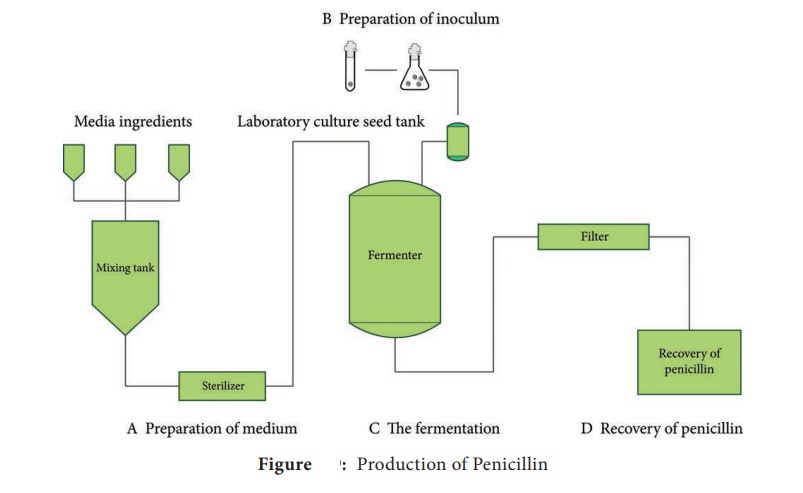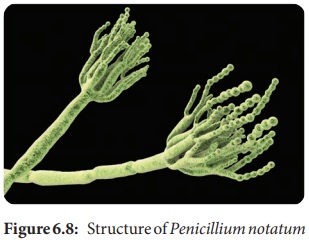Industrial Microbiology - Industrial Production of Penicillin | 12th Microbiology : Chapter 6 : Industrial Microbiology
Chapter: 12th Microbiology : Chapter 6 : Industrial Microbiology
Industrial Production of Penicillin

Penicillin Production
Penicillin
is a broad spectrum antibiotic. Penicillin is first obtained from the mould, Penicillium notatum (Figure 6.8).

Penicillium chrysogenum is a high yielding strain, used for the
commercial production of penicillin. This strain is highly unstable, so the
spore suspensions are maintained in a dormant state to prevent contamination.
Most penicillin form filamentous broth and hence is difficult to mix and it
hinders oxygen transfer due to their high viscosity. This is avoided by using
bubble columns air lift reactors which agitates the medium providing even
oxygen distribution.
Penicillin has a basic structure 6-amino penicillanic acid
6-(APA). It consists of a thiazolidine ring with a condensed β-lactum ring. It
carries a variable side chain in position 6. Natural penicillins are produced
in a fermentation process without adding any side chain precursors. If a side
chain precursor is added to the broth, desired penicillin is produced and it is
called bio-synthetic penicillin.
Semi synthetic penicillin is one in which, both fermentation and
chemical approach are used to produce useful pencillins. It can be taken orally
and active against gram negative bacteria. (eg) Amphicilin. Nowadays, semi synthetic
pencillins makeup the bulk of the penicillin market.
Infobits
In later (1939) using (Flemings’ work) Howard Florey and Ernst
Chain managed to purify penicillin in a powdered form. In 1941, they
successfully treated a human. In 1943, they produced penicillin on a large
scale. This helped immensely to treat causalities during the 2nd World War ww1
that had bacterial inflations due to their wounds.
The main objective of producing semi synthetic penicillin is to generate compounds with improved
properties. (eg) acid stability, Resistance to enzymic degradation, broader
spectrum of activity. Here side chain is removed to form (6 - APA) via
immobilization in a column of penicillin acylase. Penicilln is converted to
(6-APA) and phenyl acetic. Then it is chemically to acylated produce Semi
Synthetic Pencillin.New kinds of synthetic penicillin can also be produced
which are readily absorbed by the intestine compared to natural penicillin.
Example: Phenithicilin.
The
initial strain of Penicillium chrysogenum (NRRL, 1951) was low yielding strain
and so it is was treated with mutagenic agents such as X-rays, UV right and
some other repeated methods to get a high yielding strain Q-176.
Production methods
Penicillin
production is done by one of the following.
1. Surface
culture
2. Submerged
fermentation process
Inoculum Production
Inoculation methods
To
inoculate fermentation medium one of the following methods can be employed.
1. Using
dry spores to seed the fermentation medium.
2. Making
suspension along with non toxic wetting agent like Sodium lauryl sulphate and
inoculating germinated organism
3. Using
pellet inocula obtained by the germination of spores
The
lyophilized spores (or) spores in well sporulated frozen agar slant are
suspended in water or in a dilute solution of a nontoxic wetting agent.
(1:10,000 sodium lauryl sulphonate)
↓
Spores
are then added to a bottles containing wheat bran solution It is incubated for
5-7 days at 24°C for heavy sporulation
↓
The resulting spores are then transferred to
production tank
↓
The micro
organism in the inoculumtank is checked for contamination.
Production process
The production
tanks are inoculatedwith a mycelial growth
↓
Production
medium contains following medium components.
Carbon
source as Lactose, Nitrogen source as Ammonium sulphate, Acetate or Lactate
(Corn steep liquor is the cheap and easy source of nitrogen)
Mineral
sources as K, P (Potassium di hydrogen phosphate), Mg, S (Magnesium sulphate),
Zn, Cu(Copper sulphate) (Corn steep liquor supply some of these minerals)
Precursor
(Example: phenyl acetic acid)is added to the medium
↓
Antifoam
agent (Example: corn orsoybean oil) is added before sterilization
The
sufficient aeration and agitation is given and are incubated at 25°C to 26°C
for 3 to 5 days at PH range of 7 to 7.5
Penicillin Production
Process
of penicillin production occurs in three phases
First
phase: Growth of mycelium occurs in this phase where the yield of antibiotic is
low. The pH increases due to the release of NH3.
Second
phase: In this phase, intense synthesis of penicillin occurs due to rapid
consumption of Lactose and Ammonium nitrogen. The mycelial mass increases and
the pH remain unchanged (Figure 6.9).

Third
phase: In this phase, the concentration of antibiotics decreases in the medium.
Autolysis of mycelium starts, liberating Ammonia leading to slight rise in pH.
Recovery
After penicillin
fermentation, the brothis filtered on rotary vacuum filte
↓
Mycelium
is separated
↓
To the
broth sulphuric acid or phosphoric acid is added
↓
Penicillin
is converted into anionic form
↓
It is
extracted in counter current solvent extractor, by using organic solvent, amyl
acetate, methyl isobutyl ketone)
↓
It is
then back extracted with water from the organic solvent by adding potassium or
sodium hydroxide
↓
Shifts between
water and solvent aid in the purification of penicillin
↓
The
resulting sodium or potassium penicillin is then crystallized
↓
Then it
is washed, dried and used for commercial purpose
Related Topics